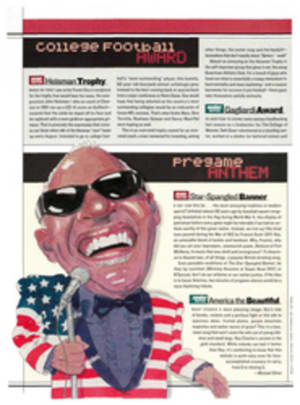
The Tortoise Wins Again Phil Mickelson hoped for a big win at the PGA, but steady David Toms had the storybook ending
David Toms, a down-the-middle golfer with a plain manner and the
drab clothes of the modern professional, had just made a hole in
one. It was a 227-yard shot, over a pond, that landed on the
green and bounced three times before smacking the flagstick and
disappearing into the dark safety of the 15th hole at the Atlanta
Athletic Club. This was last Saturday, in the third round of the
PGA Championship. Suddenly Toms, at age 34, had a one-stroke lead
in the year's last major--a one-stroke lead over the anti-Toms,
the flamboyant Phil Mickelson, with his alligator-skin shoes and
his Hugo Boss duds and his outsized talent.
For a moment Toms looked as though he didn't know what to do. His
playing partner, Shingo Katayama of Japan, with the toy rodeo hat
and the infectious enthusiasm, was smiling more than Toms was at
the ace. Then Toms, a lifelong Louisianan, started whooping as if
he were at one of his beloved LSU football games. The crowd
whooped it up too, as it does whenever a hole in one is made, but
it wasn't the kind of pandemonium that would have erupted if
Mickelson had hit the shot.
Mickelson was at the next hole. "I heard the noise," he said
after the round. "It didn't sound to me like a hole in one." He
wasn't being mean, only truthful. Had Mickelson made that ace, he
would have put on his "aw, just lucky again," Cheshire-cat grin,
and his fans would have been delirious. They've suffered with him
long enough.
This PGA was supposed to be the one at which Mickelson, 31,
busted out and won his first major. He had been in contention at
the Masters in April and at the U.S. Open in June. Tiger Woods
was struggling with his game--so much so that he had to battle to
make the cut. Lefty's time had arrived.
Mickelson has won 19 Tour events. He has endorsement contracts
worth tens of millions of dollars. He lives in a mansion in
Scottsdale, Ariz., and flies around the country in his own
private jet. Before the first ball was struck at Atlanta, he
spoke of his desire not only to win but also to dominate, to
claim victory by "a certain number of strokes." That would add to
the majesty of the walk up the 18th fairway on Sunday, knowing he
could six-putt and still win. That's the kind of thing Woods has
done. Mickelson is the best player never to have won a major,
and, as gracefully as he wears that sash, he was ready to bury
it.
Toms is a more anonymous sort. He had won five times on the Tour
before last week but has no million-dollar endorsement deals.
When he needs to get on a plane, either he or his wife, Sonya,
calls their travel agent.
The two men came to Atlanta with a bit of shared history,
although Mickelson may not have known it. When he was at Arizona
State and Toms at LSU, they played in the same NCAA tournament in
1989. (Mickelson, a freshman, won it; Toms, a senior, finished
eighth.) Toms was a nice college player, even made All-America in
the 1988-89 season. Mickelson was a legend, a prodigy who holed
impossible shots. He was a four-time first-team All-America. In
January 1991, when Mickelson was a college junior, he won a Tour
event, the Tucson Open. At that moment Toms, who had turned pro
in '89, was packing his bags for the Asian tour, going wherever
he needed to go to learn the professional game.
In the years since, Mickelson has become more aware of Toms. In
May, at the Tour stop in New Orleans, Toms closed with a 64.
Mickelson, who had begun the day with a three-stroke lead,
scuffled home in 72, finishing second, two shots behind Toms.
Last week they stayed in their roles. Mickelson spoke of his
desire "to steal one back" from Toms. Toms said that if he were a
golf fan instead of a touring pro, Mickelson would be the guy he
would follow--for the bombs he hits off the tee, for his frequent
chip-ins, for the excitement of his game.
Then came Sunday afternoon, when they were paired in the final
group, the only two golfers in the field to have broken 200 for
the first three rounds. (Toms had shot 66, 65, 65--14 under par on
the par-70 course, which measures 7,213 yards. Mickelson had shot
66, 66, 66.) After 14 holes Mickelson had to defer one dream: He
could still win, but he couldn't win big. Toms, even though he
was outdriven by Mickelson by 50 yards on some holes, was still
leading by two. Then came the 15th. The flashy one chipped in for
a birdie, while Toms found a bunker off the tee and made a bogey.
Mickelson had a share of the lead again.
On Saturday, after Toms had aced the 15th with that spectacular
five-wood shot, he stood on the 16th tee and blocked everything
from his head except the drainage ditch he was using as an aiming
device. He smoked a perfect tee shot. Now, a day later, Mickelson
was on the 16th tee, having holed a fabulous shot on 15. The game
was on. The first major was within his grasp.
He did not seize the moment. He rattled his tee shot into the
trees, leaving himself 180 yards to the green instead of 120. His
approach shot finished 45 feet below the hole. Then the
boisterous crowd, so clearly on his side, proved to be his
undoing. Unable to turn off the voices informing him loudly about
the slowness of the putt he faced, Mickelson knocked his ball
eight feet by, then missed the putt coming back to fall to 14
under. Toms, steady as a drumbeat, made par to remain at 15
under.
Both golfers made par on 17, setting up a showdown on the 18th, a
cut-down par 5 playing as a par 4, with an enormous ball-eating
pond in front of the green. The hole is listed as 490 yards, but
it's at least 10 yards longer. Using a driver, Toms sent his tee
shot two feet into the first cut of rough. He had a downhill lie
with a third of the ball submerged in the grass. Toms's feet were
below the ball, and he had 209 yards to the hole. He did not have
a club with which he could stop the ball on the green.
Do you think Mickelson would have gone for the green in that
situation? No doubt about it, just as he did on the last day at
Pebble Beach this year by hitting a driver off the deck for his
second shot on the par-5 18th. (He knocked the ball in the
ocean.) The man plays heroic shots, in the tradition of Arnold
Palmer. Often he pulls them off. That's why he's popular.
Toms plays modest shots, rooted in realism. He blocked out the
voices in the crowd, the ones urging him to go for broke with his
magical five-wood. Instead he hit a pitching wedge to 88 yards,
then hit a full lob wedge 10 feet from the hole.
Off the tee Mickelson had drilled a three-wood long and in the
fairway. He then smashed his approach shot to 25 feet, left his
birdie putt three inches short and tapped in. He had done all he
could. Now it was his opponent's turn.
Toms read the putt with a clear mind. His stroke was perfect,
just as Payne Stewart's had been after he laid up in similar
fashion on the last hole of the 1999 U.S. Open at Pinehurst.
Stewart knocked in an 18-footer to beat Mickelson by a shot.
Toms's putt dropped for a closing 69 and a four-round total of
265. Nobody has taken fewer strokes in a major.
It was 10 minutes before a disconsolate Mickelson reached his
wife, Amy, who is seven months pregnant. They kissed. "I'm all
right," the golfer said wearily. He looked like a man whose dog
had just been run over.
A few feet away Sonya Toms had moments earlier made a call on her
cell phone, changing an airline reservation. "We definitely
cannot make the 8 o'clock flight," she said gleefully.
Mickelson cleared out his locker, leaving behind a club history
that had been given to the players. Jerry Pate won the U.S. Open
at the Atlanta Athletic Club in 1976. Larry Nelson won the PGA
Championship there in '81. Mickelson had come to Atlanta looking
to win his first major, to make some golf history. Now he must
wait eight months for his next chance, at the Masters. On Sunday
night he talked about his ongoing desire to win "a bunch" of
majors. He's always focused on something big.
Toms talked about the blisters on his heels. "I'm sure there's
blood everywhere in my shoes," he said. He took home the
Wanamaker Trophy. All he left behind was his blood.
COLOR PHOTO: BRANT SANDERLIN/ATLANTA JOURNAL-CONSTITUTION/AP [T of C]
COLOR PHOTO: PHOTOGRAPH BY SIMON BRUTY Bunker mentality Toms won his first major by staying out of trouble--and minimizing the damage when he didn't.
COLOR PHOTO: ROBERT BECK
Toms said that if he were a golf fan instead of a touring
professional, Mickelson would be the guy he would follow,
because of the excitement of his game.

